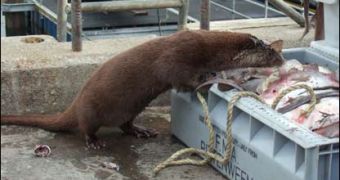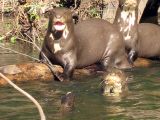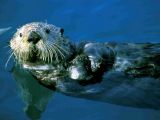1.Otters are nothing more than water weasels. The oldest otter was found in France: Potamotherium, 30 million years old. The upper carnassial teeth were similar to those of a seal, very different from those of the weasels. This could have also been an ancestor of the seals.
The genus Lutra, comprising most modern otters, emerged in Eurasia and spread to North America and northern Africa. The modern otter of Eurasia (Lutra lutra) was preceded by the Reeve otter 1 million year ago. This species appeared in the Upper Pleistocene, 200,000 to 90,000 years ago. In the famous Lascaux caves reindeer antlers with otter representations have been found, 25,000 years old.
2.These mammals are solitary creatures; groups of otters represent a female with her cubs. They tend to be sedentary and inhabits both freshwater and marine shores (the Eurasian otter), in rivers, lakes, slops, ditches, estuaries, swamps and coasts. A female has a territory of 25 square km (10 square mi), while the male has a larger territory, comprising those of several females. On the rivers, this translates to 10-40 km (6-25 mi) for males and 5-20 km (3-12 mi) for females. Young males usually have no territory. The territory is delimited twice a day through feces. On the Scottish coasts, rich in food, there is a breeding female for each 2-3 km (1.2-1.8 mi).
Otters communicate olfactory through the secretions of the anal glands, feces and urine. Mountain rivers use to descend to valleys during the winter.
3.Otter's food is made 50-90 % by fish (they clean the waters of ill fish). They also consume frogs and other water animals (small mammals, insects, birds, crustaceans). An adult otter consumes 0.5-1.5 kg (1.1-3.3 pounds) of food daily. The otter attacks fish from a dead visual angle, using for prey detection its vibrisae (which are 20 cm or 0.6 ft long). The crystalline lens is cambered under the water.
Otters can stay in immersion one minute, but usually they do not remain more than 20-30 seconds. Big preys are consumed on the ground.
Under the water, the tail acts as rudder, but also propeller. Ears close hermetically under the water.
In Scotland and Ireland, male otters hunt in the sea fish and crabs, while for breeding they go tens of kilometers upward in the rivers.
4.Otters breed once a year, in any season. The nuptial play, lasting 10-20 minutes, consists in a swim in two, and during the mating the male grabs the female by the neck with his teeth. The female takes care of the offspring alone. Gestation lasts 62 days and the female can give birth in any season to 1-45 cubs. The newborn are blind, have fur, and are 12 cm (5 in) long. At one month old, they weigh 700 g (1.5 pounds), at two months, over 1 kg (2.2 pounds) and by the age of 3 months they are put out of the den.
At the age of 8-9 months old, the young are weaned. First, they persist at the edge of mother's territory, then, they found their own territories. Sexual maturity is reached by the age of 2-3 years. Otters live about 10 years, but in captivity they can live up to 15 years.
In the case of the Eurasian otter, the male is 1.2-1.37 m (4-4.5 ft) long (the tail makes 40 cm or 1.3 ft) and weighs 7-12 kg (16-27 pounds) while the female is 1-1.1 m (3.3-3.6) long, weighing 5-8 kg (11-18 pounds).
5.There are 13 species of otters.
The Eurasian otter is the most widespread otter, and has several races: Lutra lutra lutra in Europe and northern Asia, barang in Indochina, Sumatra and Java, aurobrunnea in Nepal, chinensis in China, whiteleyi in Japan, meridionalis in Iran and Central Asia, seistanica in Afghanistan and Pamir, and nair in southern India and Ceylon. Today, this otter is menaced by water draining and water contamination.
Hairy nosed otter (Lutra sumatrana) is 1.05-1.35 m (3.5-4.5 ft) long (the tail making 35-50 cm or 1.2-1.6 ft). It is brown and once lived from mountain rivers to coasts in southeastern Asia, Sumatra, and Borneo. Extremely few individuals survive in Vietnam, southern Thailand, Sumatra and Cambodia, being menaced by poaching.
Speckle throated otter (Hydrictis maculicollis) is 0.95-1.2 m (3.2-4 ft) long (the tail making 35-44.5 cm or 1.2-1.6 ft). It weighs 3-9 kg (7-20 pounds). It is black with irregular white stripes on the neck. It lives in Sub Saharan Africa and eats mainly fish.
Smooth coated otter (Lutrogale perspicillata) is 1.06-1.3 m (3.5-4.3 ft) long (the tail makes 40-50 cm or 1.3-1.6 ft). The color is gray-brown. It inhabits estuaries, coasts, swamps, mangroves, large rivers. It lives from Pakistan and India (without Ceylon) to southeastern Asia, Sumatra, Borneo and Java. The subspecies maxwelli lives isolated in the swamps of southern Iraq. It eats mainly fish.
Northern river otter (Lontra canadensis) is 1-1.5 m (3.3-5 ft) long (the tail makes 31.5-40 cm or 1-1.3 ft). It is brown and weighs 8-12 kg (20-26 pounds). It inhabits lakes, rivers, swamps, rocky sea coasts in Alaska, Canada and US. It eats fish and amphibians. In this species the development of the embryo is delayed for 8 months.
Southern river otter (Lontra provocax) is 1-1.15 cm (3.3-3.5 ft) long (the tail makes 35-45 cm or 1.2-1.5 ft) and weighs 5-9 kg (11-20 pounds). It is black and lives between 36 and 52o S, in Argentina and Chile, in river, lakes and estuaries. It feeds on crustaceans, clams and mussels.
Neotropical river otter (Lontra longicaudis) is 0.9-1.3 m (3-4.3 ft) long (the tail makes 37.5-57 cm or 1.3-1.8 ft). It weighs 9-15 kg (20-33 pounds). It is dorsally brown and silver or tawny below. It lives from forested rivers to coastal swamps, from Central America to South America. It feeds on fish and crabs. This species is intensively poached for its fur.
Marine otter (Lontra felina) is 0.87-1.15 m (2.8-3.8 ft) long (the tail makes 30-36 cm or 1-1.2 ft). It weigh 3-6 kg (7-14 pounds), being brown. It lives in windy shore areas and coastal rocky islands in Chile and Peru. From Argentina, it has disappeared. It feeds on crustaceans, mollusks and fish (30 %). It is diurnal and menaced with extinction.
Giant otter (Pteronura brasiliensis) is 1.5-2.4 m (5-8 ft) long and weighs 22-34 kg (48-72 pounds). It lives in large rivers in Brazil and Guyanas. It eats fish and young caymans and anacondas. It is diurnal and extremely sociable. It is hunted by caymans, anacondas and jaguars, and extremely poached for its fur. This is the largest species in the family of weasels (Mustelidae).
African clawless otter (Aonyx capensis) (also called white collared otter) is 1.17-1.62 m (3.5-5.5 ft) long (the tail making 40-67 cm or 1.3-2.3 ft). It weighs 15-20 kg (33-44 pounds) being brown with white neck. It inhabits rivers and lakes in the Sub Saharan Africa. It feeds on crabs, frogs and fish.
Congo clawless otter (Aonyx congicus) lives in wet habitats in central Africa.
Oriental small clawed otter (Aonyx cinereus) is 0.65-0.94 m (2.2-3.2 ft) long (the tail makes 24-35 cm or 0.8-1.2 ft). It weighs 3-6 kg (7-14 pounds). Claws are rudimentary. It inhabits small rivers and rice ditches, from mountains to shores, in India (without Ceylon), Bangladesh, southeastern Asia, Borneo, Sumatra, Java, Philippines. They feed on crabs, mollusks and fish and are trained for fishing by humans.
Sea otter (Enhydra lutris) is up to 1.63 m (5.5 ft) long. It weighs 20-45 kg (44-100 pounds). The fur is extremely dense, up to 800 millions of hair per adult (the record amongst all mammals!). It lives off shores and on islets in the northern Pacific, California, and Alaska. It feeds on fish, mollusks, crabs and sea urchins. It is one of the few mammals using tools: sea urchins are crashed using stones.

 14 DAY TRIAL //
14 DAY TRIAL // 

